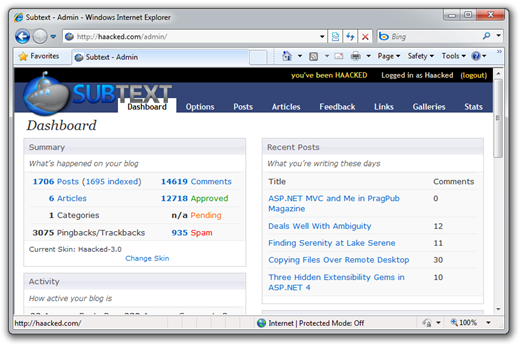Subtext 2.5 Released!
Wow, has it already been over a year since the last major version of Subtext? Apparently so.
Today I’m excited to announce the release of Subtext 2.5. Most of the focus on this release has been under the hood, but there are some great new features you’ll enjoy outside of the hood.
Major new features
- New Admin Dashboard: When you login to the admin section of your
blog after upgrading, you’ll notice a fancy schmancy new dashboard
that summarizes the information you care about in a single
page.
 The
other thing you’ll notice in the screenshot is the admin section
received a face lift with a new more polished look and feel and
many usability improvements.
The
other thing you’ll notice in the screenshot is the admin section
received a face lift with a new more polished look and feel and
many usability improvements. - Improved Search:We’ve implemented a set of great search improvements. The biggest change is the work that Simone Chiaretta did integrating Lucene.NET, a .NET search engine, as our built-in search engine. Be sure to check out his tutorial on Lucene.NET. Also, when clicking through to Subtext from a search engine result, we’ll show related blog posts. Subtext also implements the OpenSearch API.
Core Changes
We’ve put in huge amounts of effort into code refactoring, bulking up our unit test coverage, bug fixes, and performance improvements. Here’s a sampling of some of the larger changes.
- Routing: We’ve replaced the custom regex based URL handling with ASP.NET Routing using custom routes based on the page routing work in ASP.NET 4. This took a lot of work, but will lead to better control over URLs in the long run.
- Dependency Injection:Subtext now uses Ninject, an open source Dependency Injection container, for its Inversion of Control (IoC) needs. This improves the extensibility of Subtext.
- Code Reorganization and Reduced Assemblies: A lot of work went into better organizing the code into a more sane and understandable structure. We also reduced the overall number of assemblies in an attempt to improve application startup times.
- Performance Optimizations:We made a boat load of code focused performance improvements as well as caching improvements to reduce the number of SQL queries per request.
- Skinning Improvements:This topic deserves its own blog post, but to summarize, skins are now fully self contained within a folder. Prior to this version, adding a new skin required adding a skin folder to the /Skins directory and then modifying a central configuration file. We’ve removed that second step by having each skin contain its own manifest, if needed. Most skins don’t need the manifest if they follow a set of skin conventions. For a list of Breaking changes, check out our wiki.
Upgrading
Because of all the changes and restructuring of files and directories, upgrading is not as straightforward as it has been in the past.
To help with all the necessary changes, we’ve written a tool that will attempt to upgrade your existing Subtext blog.
I’ve recorded a screencast that walks through how to upgrade a blog to Subtext 2.5 using this new tool.
Installation
Installation should be as easy and straightforward as always, especially if you install it using the Web Platform Installer (Note, it may take up to a week for the new version to show up in Web PI). If you’re deploying to a host that supports SQLExpress, we’ve included a freshly installed database in the App_Data folder.
To install, download the zip file here and follow the usual Subtext installation instructions.
More information
We’ll be updating our project website with more information about this release in the next few weeks and I’ll probably post a blog post here and there.
I’d like to thank the entire Subtext team for all their contributions. This release probably contains the most diversity of patches and commits of all our releases with lots of new people pitching in to help.
Comments
14 responses